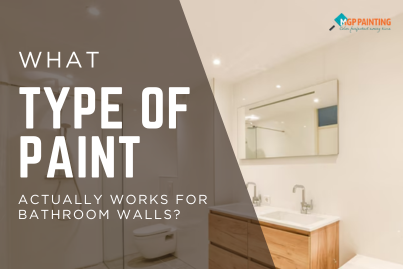So... What Type of Paint Actually Works for Bathroom Walls?
Real Talk for Bergen County Homeowners
Let’s get this out of the way—bathrooms are chaos for paint. If you've ever dealt with bubbling walls, mystery stains, or that weird peeling in the corners… yeah, you're not alone. I live in Bergen County, and trust me, the combination of humidity and temperature swings here makes it worse.
So if you're thinking about freshening up your bathroom, let’s talk real:
What kind of paint doesn't betray you six months in?
Why Bathroom Paint Isn't Just... Paint
You’d think paint is paint, right? Nope. Bathrooms are humid, hot, constantly cleaned, and full of moisture-loving enemies like mold. If you use the wrong type, it’s basically like putting paper armor in a rainstorm.
Here’s what your bathroom paint should be doing behind the scenes:
- Holding off mildew like a champ
- Letting you wipe it down without stripping the color
- Surviving steam, heat, and towel-flinging chaos
If your walls have started bubbling, fading, or smelling musty, it might be time to reevaluate your last paint job. This quick guide on when to repaint breaks down the signs before damage gets out of hand.
What’s Actually Good for Bathroom Walls?
I’ve tried a few types—some with regrets, some I’d use again in a heartbeat. Here’s the shortlist:
1. Semi-Gloss Paint
Let’s be honest, it’s not the fanciest finish, but it holds up. It’s shiny (but not like 90s kitchen shiny), and super easy to wipe.
Where it works: Around the sink, near the tub—anywhere stuff gets splashed.
2. Satin Finish Paint
Satin’s like semi-gloss’s cool cousin. A little more chill, still durable. Has a soft look but doesn’t flake out under pressure.
When to use it: If your bathroom has good airflow. If not... skip it.
3. Mold-Resistant Latex Paint
Honestly? This one’s underrated. Low smell, dries fast, and has ingredients that keep mold from settling in.
Perfect for: That one bathroom nobody bothered to install a fan in. You know the one.
For more detailed pros and cons, check out this full breakdown of the best paint types for bathrooms—especially useful if you're stuck between finishes.
4. Special Bathroom-Specific Paints
Yes, they’re a thing. No, they’re not just marketing fluff. These paints are built for high-humidity spaces and usually include mildew-fighting features.
Why I like them: They’re not cheap, but if you don’t want to repaint for another 7–10 years, totally worth it.
Please Don’t Use These (Learned the Hard Way)
- Flat or Matte Paint: It looks amazing for about... two weeks. Then the moisture hits and it's like painting with regret.
- Oil-Based Paints: Unless you really love fumes and slow drying times, just don’t. There are better modern options now.
Side note: I once used matte in my half-bath to “try something bold.” Worst idea ever. Steam + flat paint = peeling sadness.
Been there, too. That’s part of why we started sharing tips and no-nonsense guidance with homeowners through MGP Painting—so you can skip those costly experiments.
Bergen County Favorites: Paints That Locals Actually Trust
If you’re shopping around locally, here are some tried-and-true options you’ll find at most home improvement stores (or recommended by painters who've done this for a while):
- Benjamin Moore Aura® Bath & Spa – Yes, it’s matte. But it's a magic matte.
- Sherwin-Williams Duration® Home – Tough as nails and scrubbable.
- Behr Premium Plus Ultra® – Solid value with built-in primer.
You’ll find these in Ridgewood, Hackensack, Paramus—just check your nearest hardware or paint store.
Choosing a finish is easier when you’ve got input from pros who work with these brands every week. Our Bergen County painting service is built around what actually works in local homes—and what doesn’t.
Thinking About Painting Your Bathroom in Bergen County?
Here's the deal — you don't need a complete renovation to make your bathroom feel amazing. Just picking the right paint can brighten up an entire space and make it seem newer and easier to live with.
If you're here in Bergen County, and you deal with damp winters and muggy summers (which is a lot of us), choosing paint that can withstand all of that is even more important. And if DIY isn't your thing (no judgment), hiring a local painter who knows the quirks of North Jersey homes can save you a ton of hassle.
Because no one wants to redo the same wall twice. Especially in a bathroom.
Bathroom Paint FAQs (Stuff Everyone Asks)
1. Do I really need special paint for bathrooms?
Yes. Regular wall paint might look fine for a while, but moisture will catch up with it. Then... mold.
2. Is satin or semi-gloss better?
If your bathroom is steamy or poorly ventilated, go with semi-gloss. Satin is fine if you’ve got a window or a strong fan.
3. What do I need to do before painting?
Here’s the quick checklist:
- Wipe everything down with a mildew-fighting cleaner
- Fill in holes, cracks, or dents
- Lightly sand glossy areas
- Prime, especially if you’re going from dark to light
4. How often do I need to repaint?
Usually every 5–7 years. Or when your walls start looking tired. Or if your last DIY job didn’t hold up (we’ve all been there).
